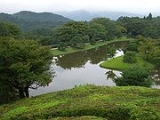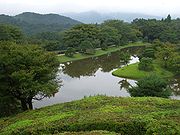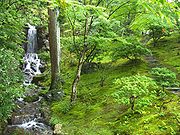
Shugaku-in Imperial Villa
Encyclopedia


Kyoto
is a city in the central part of the island of Honshū, Japan. It has a population close to 1.5 million. Formerly the imperial capital of Japan, it is now the capital of Kyoto Prefecture, as well as a major part of the Osaka-Kobe-Kyoto metropolitan area.-History:...
, Japan
Japan
Japan is an island nation in East Asia. Located in the Pacific Ocean, it lies to the east of the Sea of Japan, China, North Korea, South Korea and Russia, stretching from the Sea of Okhotsk in the north to the East China Sea and Taiwan in the south...
(separate from the Kyoto Imperial Palace). It is one of Japan's most important large-scale cultural treasures; its gardens are one of the great masterpieces of Japanese garden
Japanese garden
, that is, gardens in traditional Japanese style, can be found at private homes, in neighborhood or city parks, and at historical landmarks such as Buddhist temples, Shinto shrines and old castles....
ing.
Although styled as a "detached palace", often translated as "imperial villa", there were never any large-scale buildings there, as there are at the Katsura Imperial Villa
Katsura Imperial Villa
The , or Katsura Detached Palace, is a villa with associated gardens and outbuildings in the western suburbs of Kyoto, Japan...
. The 53-hectare (133 acre) grounds actually include three separate gardens, the Lower Garden, Middle Garden (a later addition), and Upper Garden, of which the latter is the most important.
The Imperial Household Agency
Imperial Household Agency
The is a government agency of Japan in charge of the state matters concerning Japan's imperial family and also keeping the Privy Seal and the State Seal...
administers it, and accepts visitors by appointment.
History
The Shugaku-in was originally constructed by the retired Emperor Go-MizunooEmperor Go-Mizunoo
was the 108th Emperor of Japan, according to the traditional order of succession.Go-Mizunoo's reign spanned the years from 1611 through 1629.This 17th century sovereign was named after the 9th century Emperor Seiwa and , translates literally as "later;" and thus, he could be called the "Later...
, starting in 1655, with the initial construction completed in 1659. The site had been previously occupied by the Enshō-ji nunnery, founded by his oldest daughter, Princess Ume-no-miya; it was moved to Nara
Nara, Nara
is the capital city of Nara Prefecture in the Kansai region of Japan. The city occupies the northern part of Nara Prefecture, directly bordering Kyoto Prefecture...
to make room for Go-Mizunoo's creation.
The Upper Garden contained a large artificial pond, created by building an earthen dam across a ravine; the pond contains a number of small islands. Unlike the typical Japanese garden, it is a very large stroll garden, making extensive use of the technique of "borrowed scenery". The Lower Garden was originally much more informal than what is now there; originally it was more of a simple arrival station for visiting guests.
After Go-Mizunoo's death, his daughter Princess Mitsuko became a nun, and established another temple there, the Ryinku-ji, in what later became the Middle Garden. The gardens and buildings then fell into disrepair, with some of the buildings either being destroyed, or removed. During the rule of Tokugawa Ienari
Tokugawa Ienari
Tokugawa Ienari; 徳川 家斉 was the eleventh and longest serving shogun of the Tokugawa shogunate of Japan who held office from 1787 to 1837.-First wife:...
, the 11th Tokugawa
Tokugawa shogunate
The Tokugawa shogunate, also known as the and the , was a feudal regime of Japan established by Tokugawa Ieyasu and ruled by the shoguns of the Tokugawa family. This period is known as the Edo period and gets its name from the capital city, Edo, which is now called Tokyo, after the name was...
shogun
Shogun
A was one of the hereditary military dictators of Japan from 1192 to 1867. In this period, the shoguns, or their shikken regents , were the de facto rulers of Japan though they were nominally appointed by the emperor...
, the Shūgaku-in was thoroughly renovated,
In 1883, the Shugaku-in came under the control of the Imperial Household Department (as it was then), and the large building which is currently in the Middle Garden was moved there. Other changes, such as the building of fences around the Lower and Middle Gardens, and the enclosure of the paths between them, soon followed, giving the Shūgaku-in the character it has today.
Garden features
The Lower Garden consists of an outer, landscaped area with walking paths, and an inner garden with villa, separated by a series of two bamboo fences each with a simple, wooden doorway. The villa (Jugetsu-kan) is irregularly shaped, with three principal rooms of 15, 12, and 5 tatamiTatami
A is a type of mat used as a flooring material in traditional Japanese-style rooms. Traditionally made of rice straw to form the core , with a covering of woven soft rush straw, tatami are made in standard sizes, with the length exactly twice the width...
mats in size; the largest contains a raised section for the emperor, as well as a drawing of "The Three Laughing Sages of Kokei" said to be by Ganku (1756-1839). The garden features a small brook and pond divided by a walkway embankment, and is set off from the villa by a region of coarse, white sand with white stepping-stones.
The Middle Garden contains an inner garden area with two principal buildings, again set within an outer and then inner fence. It features a fine pond predating the garden, with cascade and stone bridges. Rakushi-ken contains two principal rooms of 6 and 8 mats in size, and features two paintings by Kano Tanshin
Kano Tanshin
was a Japanese painter. He was the son of Kanō Tan'yū by his second wife, and led the Kajibashi branch of the Kanō school after 1674.- References :* * *...
. Kyaku-den, the reception hall, contains two principal rooms (12.5 and 10 mats) and an altar room (6.5 mats) added after the building was moved to this site in 1678 from the palace at Tofuku-monin. It contains a celebrated shelf of zelkova
Zelkova
Zelkova is a genus of six species of deciduous trees in the elm family Ulmaceae, native to southern Europe, and southwest and eastern Asia. They vary in size from shrubs to large trees up to 35 m tall . The leaves are alternate, with serrated margins, and a symmetrical base to the leaf blade...
wood, known as the "Shelf of Mist", paintings by Kano Hidenobu, and fine paintings on wooden panels.
The spectacular Upper Garden is reached through a simple gate and short climb through clipped shrubbery, at which point the entire garden vista is revealed. A simple pavilion of several rooms and wooden porch provides an excellent vantage point, with superb views of the pond, its islands, and the surrounding Kyoto hills. The nearby waterfall is about 10 meters in height, built of rough-hewn stones, and set within a highly picturesque surrounding. The pond is ornamented with two major structures: Chitose-bashi, a relatively ornate bridge of two large, stone piers connected by a central walkway, each capped with a wooden pavilion, one of which sports a Chinese phoenix
Fenghuang
Fenghuang are mythological birds of East Asia that reign over all other birds. The males are called Feng and the females Huang. In modern times, however, such a distinction of gender is often no longer made and the Feng and Huang are blurred into a single feminine entity so that the bird can be...
of gilt copper; and Kyusui-tei, a simple, single-room building (18 mats) which is original. The pond also features two smaller bridges, a stone boat-landing, and a second, smaller waterfall. The pond's west bank is long and remarkably monotonous, with lawn, trees, walkway, and clipped hedge running atop the large, earthen-work dam that created the pond.
The three gardens are linked by two straight allée
Allee
Allee may refer to:* Alfred Allee , U.S. sheriff.* J. Frank Allee , U.S. merchant and politician.* Warder Clyde Allee , U.S. ecologist, discoverer of the Allee effect.* Verna Allee , U.S. business consultant....
s, each perhaps 100 meters in length and lined by regular plantings of pine trees, that run through surrounding rice plantations and offer excellent views of both the plantations and the nearby hills.
Further reading
- Yoshiro Taniguchi, Jiro Harada, Tatsuzo Sato, The Shugakuin Imperial Villa (Mainichi, Tokyo, 1956) (text in Japanese and English)
- Teiji Itoh, Takeji Iwamiya, Imperial Gardens of Japan (Weatherill, New York, 1970) covers the gardens in great detail
- Tadashi Ishikawa, Imperial Villas of Kyoto: The Katsura and Shūgaku-in (Kodansha, Tokyo, 1970)
- Michio Fujioka, Shigeo Okamoto, (translated Bruce A. Coats) Kyoto Country Retreats: The Shugakuin and Katsura Palaces (Kodansha, New York, 1983)

